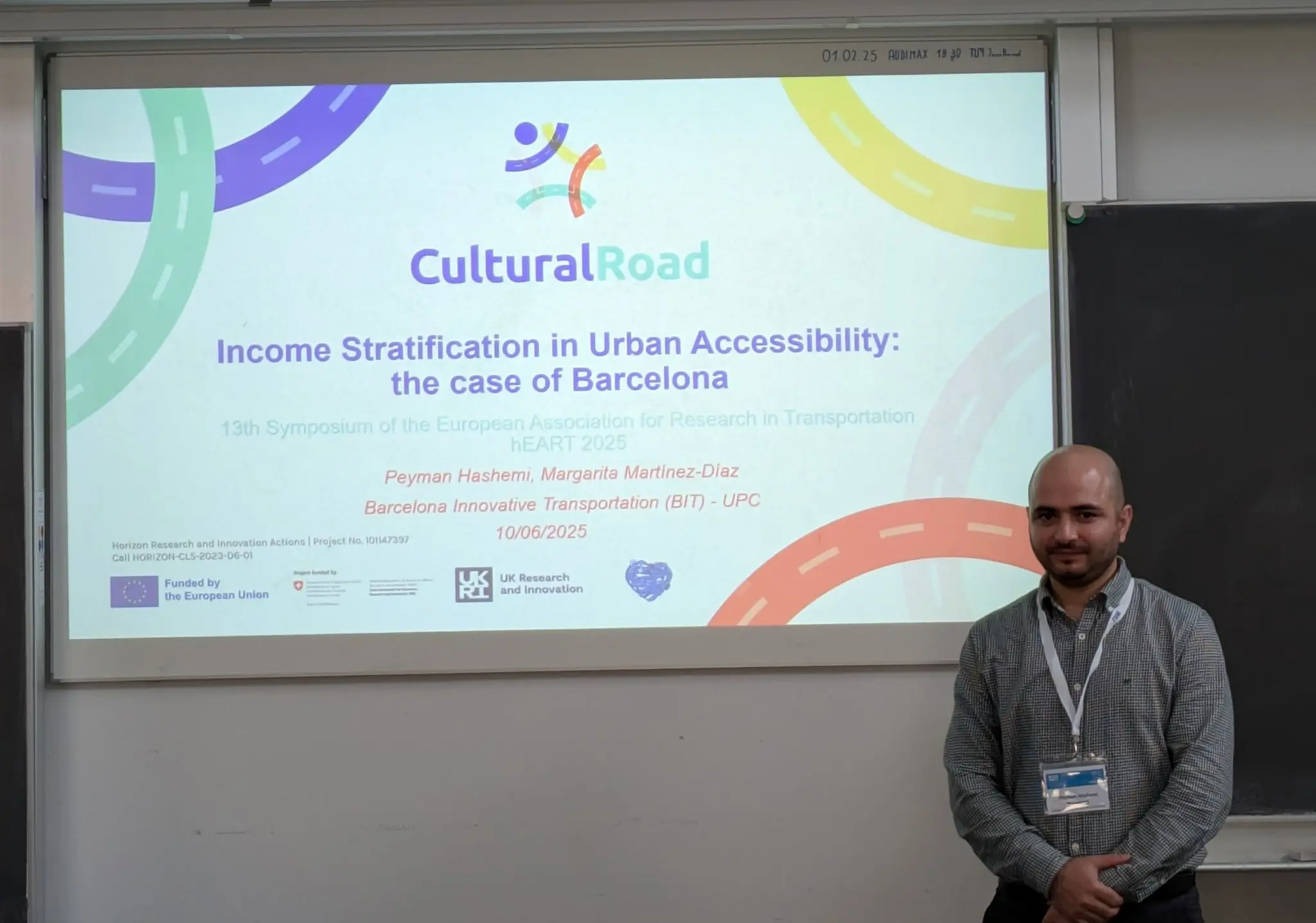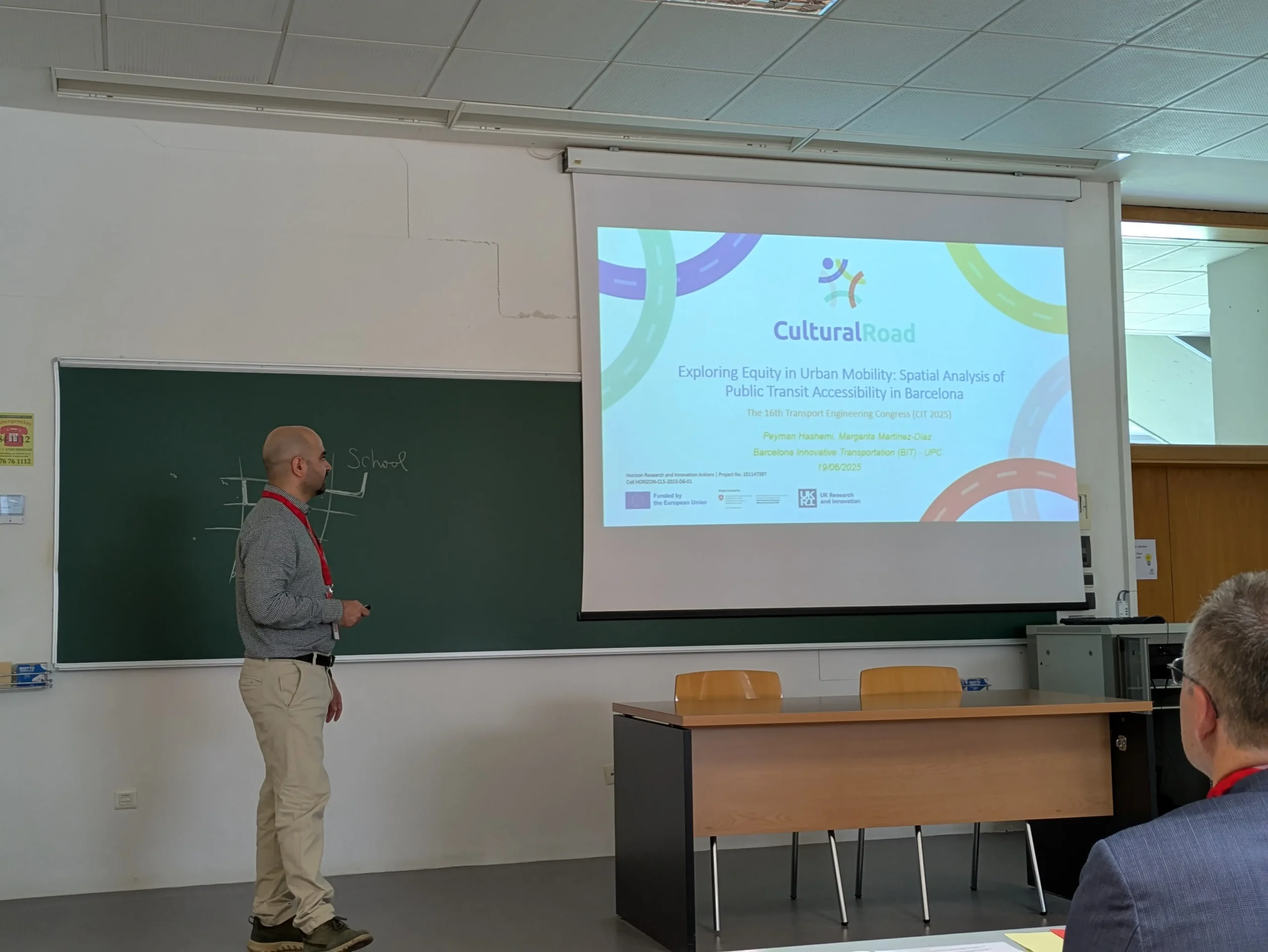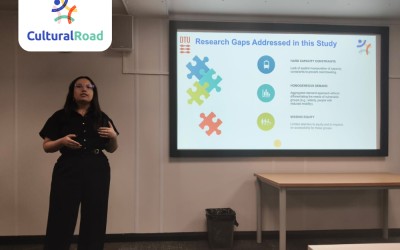CulturalRoad partner Universitat Politècnica de Catalunya (UPC) presented its recent research on public transport accessibility, with a case study focus on the city of Barcelona, at two key events held in June 2025: hEART2025 in Munich (Germany), and CIT 2025 (XVI Congreso de Ingeniería del Transporte – XVI Transport Engineering Congress) in Zaragoza (Spain). Both events offered a valuable opportunity to discuss how future transport systems can better serve everyone.
Accessibility is a key aspect explored in the CulturalRoad Inclusivity pillar, which looks at how CCAM systems can be designed for greater mobility equity for all. This can only be achieved by ensuring accessibility, i.e. that citizens can reach their destination, taking into consideration factors including time, expenses, or comfort.
hEART2025: Exploring income-based accessibility in Barcelona
The 13th Symposium of the European Association for Research in Transportation (hEART2025) was held on 10-12 June in Munich, organised by CulturalRoad partner Technical University of Munich (TUM). The event gathered leading transport research experts to discuss the latest developments in the field. CulturalRoad partners National Technical University of Athens (NTUA) and Technical University of Denmark (DTU) also attended the event, making it a valuable opportunity to exchange insights, connect with peers, and explore collaborations to strengthen the project’s impact.
Peyman Hashemi Baragoori (UPC) presented a paper titled “Income Stratification in Urban Accessibility: the case of Barcelona” as part of a session on transport equity. The paper examines public transport accessibility in Barcelona from an equity perspective, focusing on disparities in access to essential services across income and sociodemographic groups. The analysis applies four distinct accessibility measures: Cumulative Opportunities, Gravity-based, Shen-based, and Spatial Availability, to assess access from residential blocks to nine categories of Points of Interest (POIs), including education, healthcare, and retail.
The results demonstrate that each measure captures different dimensions of accessibility, with Cumulative Opportunities and Gravity-based measures showing mostly similar trends, while the Shen-based and Spatial Availability measures sometimes reveal different patterns, as they account for competition among individuals for available opportunities. Accessibility for lower- to middle-income groups varies depending on the POI category and the measure used, while middle- to upper-middle-income groups generally experience increasing accessibility. However, accessibility tends to decline for the highest-income groups. Despite Barcelona’s relatively comprehensive public transport network, the study reveals ongoing spatial and social imbalances.
These findings underscore the importance of using multiple accessibility metrics and considering competition effects to support more equitable urban planning and service delivery.

CIT 2025: Mapping mobility equity in Barcelona’s public transit system
Held in Zaragoza from 18 to 20 June 2025, the XVI Transport Engineering Congress (XVI Congreso de Ingeniería del Transporte) provided another platform for UPC’s accessibility research, this time focusing on spatial analysis of public transit networks. The congress discussed scientific research and innovation in the transport sector. The congress addressed key concepts in the development of mobility systems such as efficiency, electrification, ecology, and evolution, crucial considerations in the current transport context for a more integrated transport future.
Peyman Hashemi Baragoori (UPC) presented another paper on accessibility titled “Exploring Equity in Urban Mobility: Spatial Analysis of Public Transit Accessibility in Barcelona”. It presents a comprehensive analysis of public transportation accessibility in Barcelona, revealing significant spatial, temporal, and sociodemographic disparities that challenge urban mobility equity. Using cumulative opportunity metrics for ten categories of POIs, the study identifies underserved areas and examines the profiles of disadvantaged residents.
The findings indicate that central districts consistently enjoy higher accessibility, while peripheral neighborhoods face persistent limitations, with access peaking during morning hours and declining during off-peak periods. Sociodemographic analysis shows that accessibility inequities are most pronounced among residents with lower educational attainment, African-born individuals, young people, and low-income households. Although gender-based differences are minimal, income-related disparities persist, with both low- and some high-income groups experiencing limited access, though the consequences differ due to factors such as car ownership.
These results underscore the need for targeted policy interventions that improve service frequency and connectivity in peripheral areas while addressing the specific needs of vulnerable populations.




